Introduction
In today’s era of immediacy, shoppers are more demanding and quality-sensitive than in past times. Customer satisfaction is a prevailing predictor of customer retention, loyalty, and profitable relationships. In a competitive marketplace where businesses compete daily for consumers, exceptional customer fulfillment is a key differentiator and increasingly has become a valuable business strategy influencer. However, it is a challenge for companies to continually meet customer needs and expectations without a timely understanding and appreciation of current customer behaviors and their wants and needs.
Fortune 500 and SMB companies alike are rapidly transforming their listening and response touchpoints to functionally-rich Voice of Customer (VoC) digital platforms to enable them to monitor and measure actual customer interactions and feedback proactively more accurately. A VoC program can have a measurable financial impact on a business by enabling significant improvements in key metrics such as customer retention, churn, customer, spend, and cost of service.
Voice of Customer (VoC) is the systematic approach for obtaining a 360-degree view of the expectations and perceptions of the customer’s needs and wants, mining the feedback for critical insights, and interpreting the notions for new or changed strategies and plans to improve the overall customer experience.

VoC solutions are strategic tools and an extension of the corporate brand and require alignment with the organization’s business model and strategies. The most effective VoC platforms are fully customizable and allow for changes, as necessary, to support the businesses’ unique customer experience policies and processes across all business units and channels.
A successful VoC program supports proactive listening to customers in real-time, engaging active and passive feedback, understanding their needs and wants, digesting and interpreting feedback intelligently and, and enabling change and innovation quickly. The key to VoC success lies simply in understanding and appreciating what matters to customers and targeting where investment will drive growth.
According to the research by the Aberdeen Group:
“Best-in-class VoC users enjoy an almost 10x greater increase year-over-year in annual company revenue.”
VoC Program: Methodology & Techniques
The VoC phase-based methodology is used to uncover and understand the customers’ specific needs and wants within a formal and structured data collection and analysis setting.
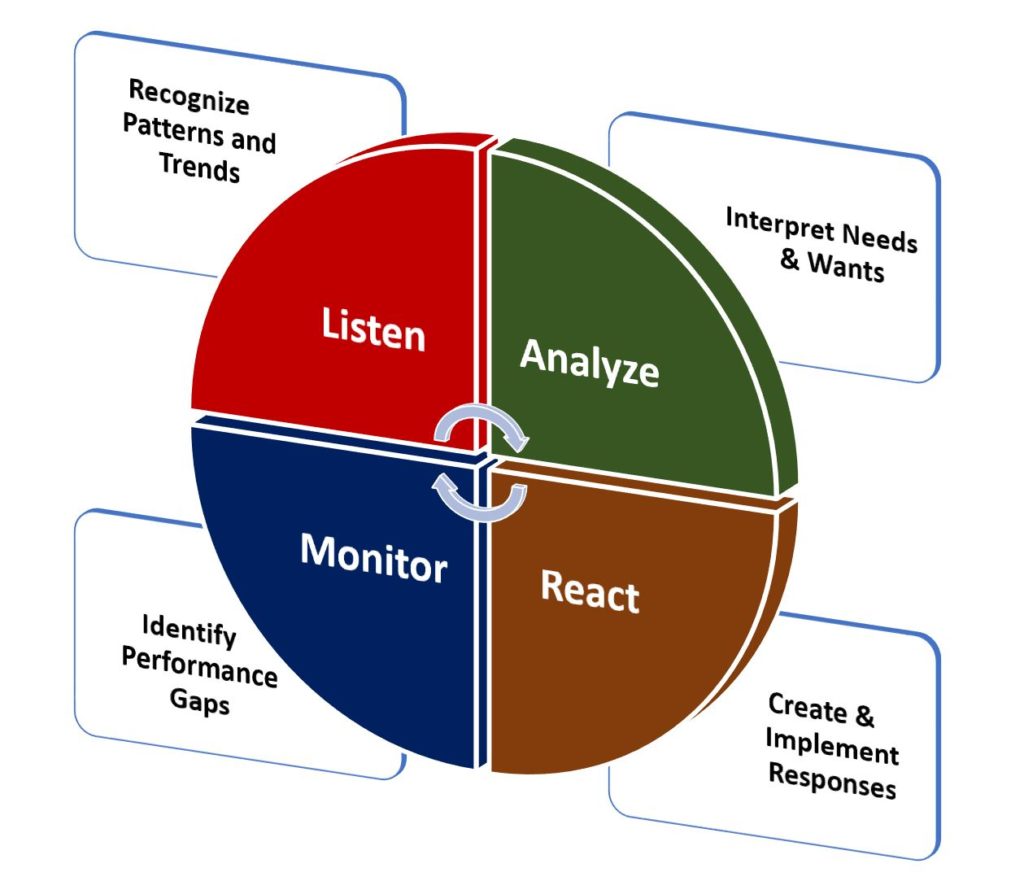
The VoC methodology includes activities to:
- Ensure that the business is actively and smartly listening to customers and delivering products and services they want and need within a cost-effective and user-friendly processing environment.
- Gather direct and indirect customer responses systematically, on any digital device, in all languages, and, at every touchpoint. The data collection covers qualitative and quantitative research steps.
- Recognize patterns and trends; organize valuable findings into a hierarchical structure (primary, secondary, and tertiary needs) and prioritize for relative importance and satisfaction with current alternatives.
- Benchmark leading competitors with the company’s customer-focused capabilities and practices and processes to identify potential gaps and identification of best practices.
- Craft pragmatic strategies and plans to retain profitable customers and safeguard and cultivate the company’s loyal customers from possible loss.
- Provide an appreciation of the customer’s requirements within a common language as a catalyst for product innovation.
“Engaging customers and winning their loyalty can be hard work. If you can’t solve their problems the first time, you risk losing their loyalty. If customers need to talk to multiple people or switch channels to get their problems solved, or if they don’t receive service on their preferred channels, they become less loyal. And, increasingly, if you can’t anticipate their next problem, they offer less value to your business in the future.”
Genesys
Formerly, businesses customarily listened to the voice of their customers through surveys, comment cards, phone transcripts, and random letters and emails, to recognize and resolve customer concerns and issues quickly. Though valuable, these individual and unaligned listening methods are no longer adequate. In the current environment, successful companies need to operate with a formal VoC program in place to systematically collect, analyze, manage, and act on customer feedback across their enterprise and ensure that feedback gets incorporated into their organization.
The leading VoC solutions and platforms contain an array of diverse, powerful, and time-tested data collection and analysis techniques. These products are highly-integrated and support the sharing of the collected customer data among the data collection techniques and across all business units and channels. These highly integrated products support the systematic collection and sharing of customer and other data for analysis and reporting purposes.
Organizations often employ a combination of collection and analysis practices together to ensure they’re covering all elements of the company’s data gathering and analysis research protocols.
A selection of commonly used techniques in VoC programs includes:
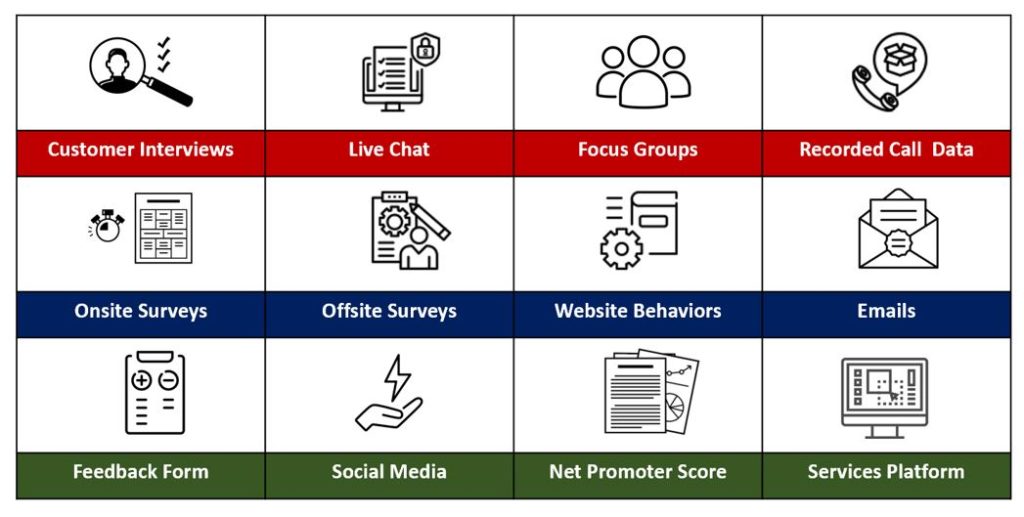
According to Gartner Group:
“Today nearly 89% of companies are competing primarily based on the level of customer experience they provide.”
VoC Program: Goals
The common goals of a VoC program, outlined below, are generally prioritized differently for companies based on their corporate strategies and plans.
- Increase customer retention rate.
- Reduce customer churn rate.
- Increase spend or share of wallet.
- Lower customer service costs.
- Increase new name customers.
- Improve cross-sells rates.
- Increase the up-sell rate.
- Increase referrals.
- Improve product and service quality.
- Improve product capability richness.
Genesys–reports:
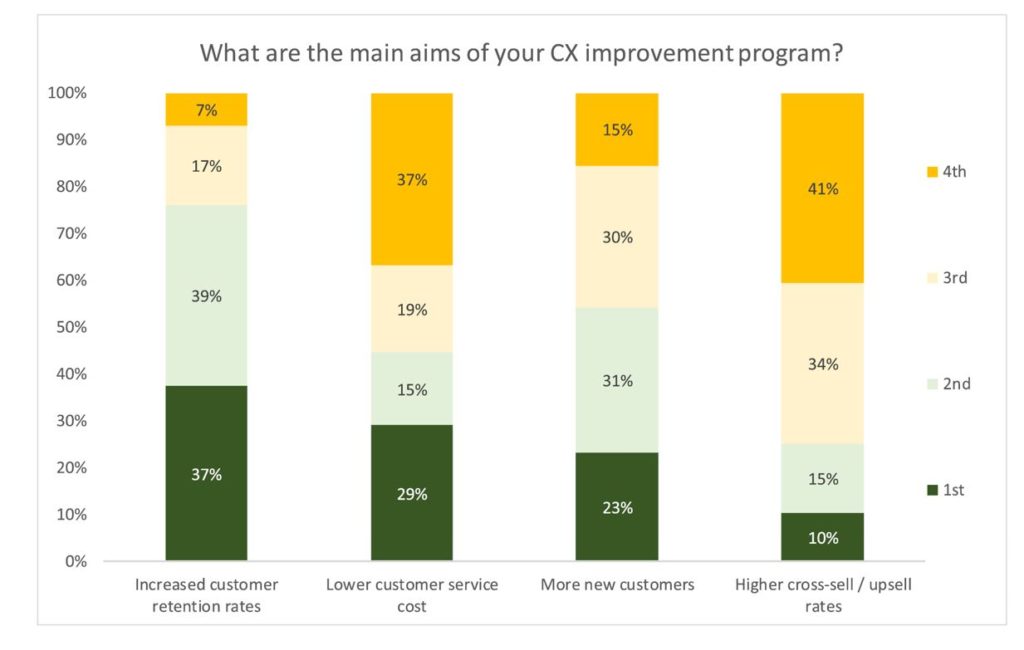
Associated Customer-Focus Definitions
The Customer Experience (CX)
The Customer Experience (CX) are sets of positive pre-sale subjective expectations and post-sale use perceptions that customers have of a company, brand, business model, and products and services. An alternative description refers to CX as the sum of all physical, emotional, subconscious, and psychological encounters a customer experiences with a business over the lifespan of their relationship. In summary, CX provides a continual value-add experience to customer relationships across every touchpoint that fulfills their expectations and perceptions.
The difficulty of retaining customers is not product or price – It’s the customer experience! That is why the most recent VoC and CX market research studies agree that about 86% of customers are willing to pay more for 5-star customer experience!
Customer Satisfaction
Customer Satisfaction is a measure of how a company’s business products and services meet or exceed customer expectations. Customer satisfaction represents the number of customers, or the percentage of total customers, whose reported experience with a business, its products, and or services (ratings) exceeds quantified satisfaction goals. Organizations unable to successfully monitor and measure customer satisfaction, are powerless to identify satisfied and unsatisfied customers!
“No one knows the cost of a defective product – don’t tell me you do. You know the cost of replacing it, but not the cost of a dissatisfied customer.”
W. Edwards Deming
Customer Value Propositions
Compelling customer value propositions focus on the total customer experience, within appropriate segments, and subject to continued updates to remain relevant. Experience confirms the incessant need for constant testing and analysis of changing customer buyer behaviors and preferences influenced by customers, competitors, and regulation changes supported by emerging technologies. This approach places customers at the top of the business’ strategic priorities and ensures the necessary funding and resource investment to maintain an attractive portfolio of products and services and support services.
The Voice of the Customer is a confirmation or repudiation of the customer value proposition!
Leading companies create policies and practices that obtain direct, immediate customer feedback, not only to secure that things are going well but also to build in methods of systematic creativity and innovation. Since customers interact with an array of touchpoints, including sales, service and customer support, and financial activities, a business is unable to convert customers into satisfied long-term repeat buyers unless it closely follows the quality of all interactions. In this regard, the customer value propositions include all business assets and capabilities that generate quantifiable and qualifiable value.
VoC Program: Best Practices
Consumer confidence in corporations and their leaders steadily declined in recent years. All of this disorder has left the typical customers wondering, “Whom can we trust?” and which business or industry will be the next to fail or apply for reorganization. In turn, in their pursuit of increasing their customer population and revenues, many companies overlooked their commitment to customers to meet or exceed their expectations.
As businesses work to restore consumer trust and loyalty and develop stronger relationships with customers, they now must think and interact differently. In this regard, they must obtain a better understanding of customers’ needs and wants by continually gathering, analyzing, and acting on customer positive and negative feedback.
The most successful VoC best practices cover:
- Gather customer feedback and data that is both useable and actionable.
- Respond to customer feedback quickly to improve the likelihood that a customer will purchase again, mainly if the company resolves the complaint in the customer’s favor.
- Listen and understand what customers are attempting to communicate, source of the feedback, and the root causes factors driving customer satisfaction or dissatisfaction.
- Establish a systematic feedback process with responsible employees responding to customer problems and requests in a set format and SLA guidelines.
- Create a closed-loop feedback process for following up on all customer feedback submitted and tracking each of those submissions through to final resolution.
- Align the VoC program to measurable business outcomes by setting goals and objectives, establishing initial baseline measurements, and regularly measuring and monitoring their progress.
“Profit in business comes from repeat customers; customers that boast about your product and service, and that bring friends with them.”
W. Edwards Deming
VoC Program: Capability Maturity Model
The VoC Capability Maturity Model is a measurement of the ability of an organization for continuous improvement in the quality of the customer experience.
Establishing a VoC Program generally progresses through four levels from the initial to the optimized to realize the full benefits of total customer experience improvement. During maturity, the focus is on a manageable set of practices and processes that enables the organization to achieve one primary goal at a time successfully. Therefore, by developing new customized approaches and plans that articulate a focused strategic purpose, the business can move to the next maturity level, thus progressively completing a customer-centric maturity path.
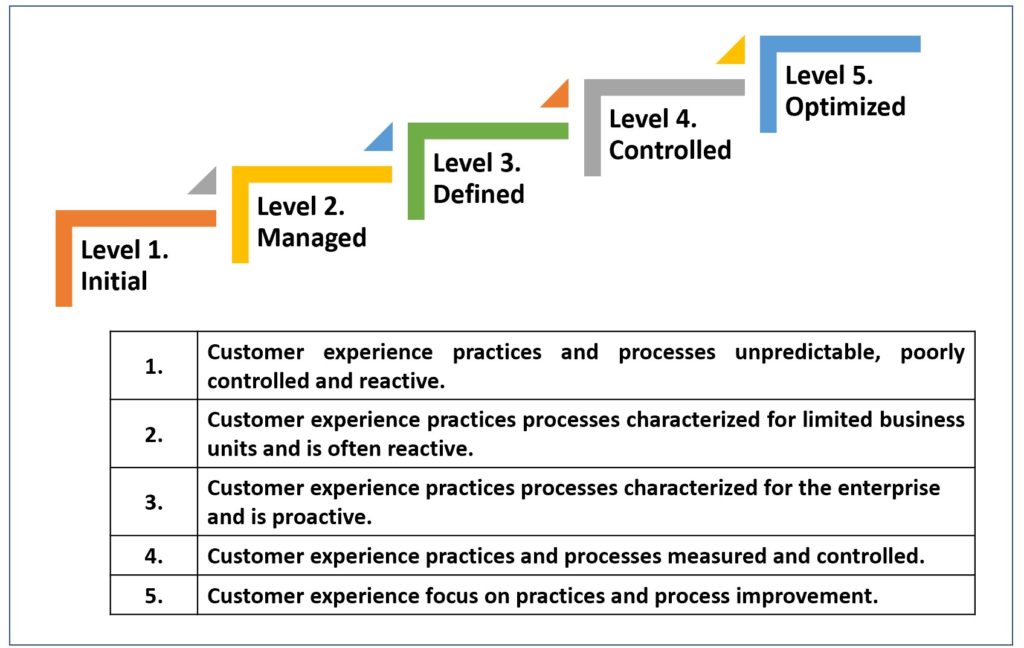
VoC Program: Metrics
Experience confirms that customer experience is a crucial driver of loyalty. For example, positive commitment increases the likelihood of repeat business with the customer more likely to forgive and forget for unavoidable slipups.
A challenge for most organizations, in VoC set-up, is agreement on customer-influenced data metrics to monitor. Many parameters are helpful to track; however, the metrics selected need to align with the company’s business model and strategies.
A selection of widely-used measurements for assessing the customer’s experience includes the below.
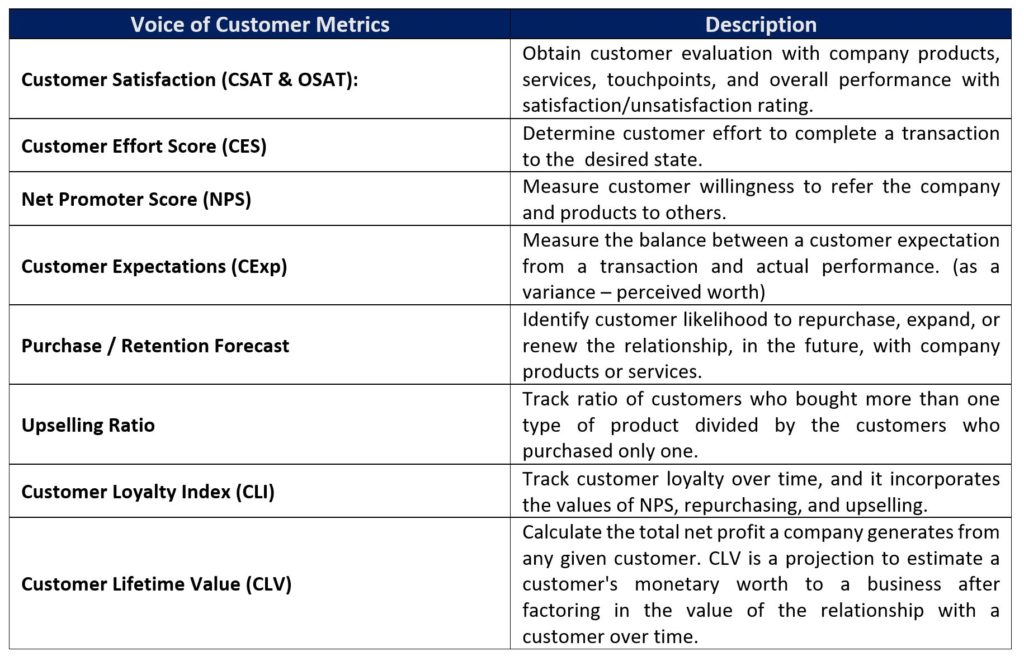
“Statistics suggest that when customers complain, business owners and managers ought to get excited about it. The complaining customer represents a huge opportunity for more business.”
Zig Ziglar
The Way Forward
At Knowledge Compass we bring together nearly four decades of thought leadership in business and technology strategy, the latest tools and best practices, and a seasoned consultant team with the competencies and talent to help our clients improve productivity and profitability of all enterprise business and support activities.
Knowledge Compass explores and develops valuable new insights from business, technology, and science by embracing the powerful technology of ideas and brainstorming. Our consultants engage customers in challenging discussion and experimentation to expand the boundaries of business science and practice and translate creative ideas into practical solutions from within and beyond business.
Working with Knowledge Compass means a collaborative approach to understanding your current business model, strategies, and key business requirements and goals.
Knowledge Compass provides consulting services with the use of an array of Frameworks, Analyses Tools, and Interactions from their Best Practices Consultant Toolbox.


